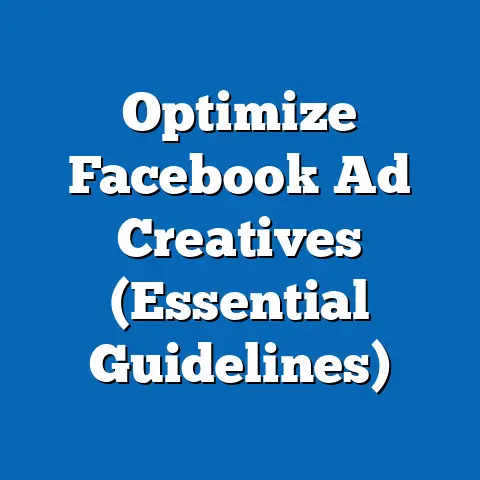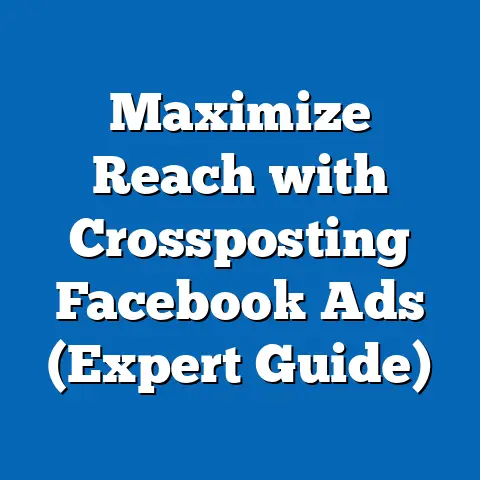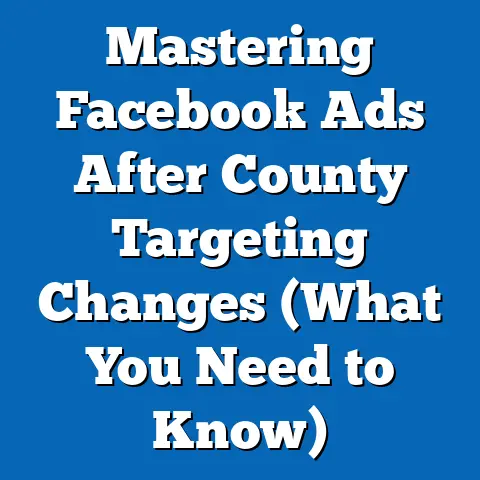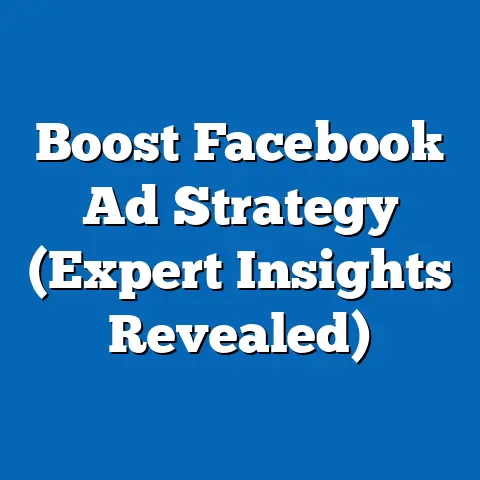Master Facebook Ads Forecasting (Essential Strategies Revealed)
In the fast-evolving world of digital marketing, forecasting the performance of advertising campaigns on platforms like Facebook has become a cornerstone of strategic planning. The ease of maintaining and optimizing these forecasts lies in leveraging data-driven tools, understanding audience behavior, and adapting to platform algorithm changes. When done effectively, forecasting can save businesses significant time and resources while maximizing return on investment (ROI).
This article delves into the essential strategies for mastering Facebook Ads forecasting, exploring its defining characteristics, historical context, and broader societal implications. We will unpack the technological, economic, and cultural factors that shape forecasting practices, drawing on both qualitative insights and quantitative data. By the end, readers will gain a comprehensive understanding of how to predict campaign outcomes with precision and the wider impact of these strategies on digital economies.
Defining Characteristics of Facebook Ads Forecasting
Facebook Ads forecasting refers to the process of predicting the outcomes of advertising campaigns on the platform, including metrics like reach, impressions, clicks, conversions, and cost-per-action (CPA). At its core, it involves analyzing historical data, audience demographics, and market trends to estimate future performance. This predictive modeling helps advertisers allocate budgets, refine targeting, and optimize creative content before launching campaigns.
One key characteristic is its reliance on machine learning and artificial intelligence (AI), which power tools like Facebook’s own Ads Manager and third-party platforms. These technologies analyze vast datasets to identify patterns and predict user behavior with increasing accuracy. Additionally, forecasting is dynamic, requiring constant updates as audience preferences shift and platform algorithms evolve.
Another defining trait is its accessibility. Unlike traditional advertising, where forecasting often required expensive market research, Facebook Ads forecasting tools are built into the platform, making them available to businesses of all sizes. However, while the tools are user-friendly, mastering them demands a deep understanding of data interpretation and strategic decision-making.
Historical Context: The Evolution of Digital Advertising Forecasting
The concept of forecasting in advertising is not new, but its application to digital platforms like Facebook marks a significant shift in methodology and scale. In the early days of advertising during the mid-20th century, forecasting relied heavily on manual surveys, focus groups, and rudimentary statistical models. These methods were time-consuming and often imprecise, limited by the lack of real-time data.
The advent of the internet in the 1990s introduced a new era of digital advertising, with platforms like Google and early social media sites offering unprecedented access to user data. Facebook, launched in 2004, revolutionized this landscape further by introducing targeted advertising based on detailed user profiles. By 2007, when Facebook Ads was officially rolled out, businesses could target audiences with precision, using demographics, interests, and behaviors—a game-changer for forecasting.
The introduction of machine learning algorithms in the 2010s marked another leap forward. Facebook began integrating predictive analytics into its Ads Manager, allowing advertisers to simulate campaign outcomes before spending a dime. Historical events like the 2018 Cambridge Analytica scandal, which raised concerns about data privacy, also influenced forecasting by prompting stricter regulations and a shift toward anonymized data aggregation. Today, forecasting must balance accuracy with compliance to evolving privacy laws like GDPR and CCPA.
Societal Implications of Facebook Ads Forecasting
The ability to forecast Facebook Ads performance extends beyond individual businesses, carrying significant societal implications. On one hand, it democratizes advertising by enabling small businesses and entrepreneurs to compete with larger corporations through cost-effective, data-driven strategies. This leveling of the playing field fosters innovation and economic diversity in the digital marketplace.
However, there are also concerns about the broader impact of hyper-targeted advertising enabled by forecasting. Critics argue that predictive models can reinforce biases, as algorithms may prioritize certain demographics over others based on historical data. Additionally, the precision of forecasting contributes to the phenomenon of “filter bubbles,” where users are repeatedly exposed to content that aligns with their existing beliefs, potentially deepening social and political divides.
Economically, forecasting drives efficiency in ad spend, which influences how resources are allocated across industries. Culturally, it shapes consumer behavior by predicting and influencing trends, often before consumers themselves are aware of their preferences. As such, mastering forecasting is not just a business imperative but a responsibility to consider its wider ethical ramifications.
Technological Factors Shaping Forecasting
Technology is the backbone of effective Facebook Ads forecasting, with several key innovations driving its evolution. At the forefront is AI, which underpins tools like Facebook’s Delivery Insights and Automated Rules. These systems analyze billions of data points in real-time, predicting outcomes based on user engagement patterns and historical campaign performance.
Another critical factor is the integration of third-party tools and APIs, such as those offered by platforms like Hootsuite or Sprout Social, which provide additional layers of forecasting precision. These tools often incorporate external data sources, such as market trends or competitor analysis, to enhance predictions beyond what Facebook’s native tools offer.
However, technological advancements also present challenges. Frequent updates to Facebook’s algorithm can disrupt forecasting models, requiring advertisers to adapt quickly. Moreover, the shift toward privacy-focused technologies, like Apple’s App Tracking Transparency (ATT) framework introduced in 2021, limits access to user data, forcing forecasters to rely on aggregated or modeled data rather than granular insights.
Economic Influences on Forecasting Practices
Economic conditions play a significant role in shaping how businesses approach Facebook Ads forecasting. During periods of economic growth, companies may allocate larger budgets to advertising, relying on forecasting to maximize reach and conversions. Conversely, in times of recession or uncertainty, such as during the 2020 COVID-19 pandemic, businesses often turn to forecasting to minimize risk and optimize limited resources.
The cost of advertising on Facebook itself is another economic factor. As competition for ad space increases, so do costs per click (CPC) and cost per thousand impressions (CPM). Forecasting helps advertisers navigate these fluctuations by identifying cost-effective targeting options and predicting when costs are likely to spike, such as during holiday seasons.
Furthermore, the rise of e-commerce, accelerated by global events like the pandemic, has heightened the importance of forecasting. With more businesses moving online, the ability to predict consumer behavior and allocate ad spend efficiently can determine a company’s survival in a crowded digital marketplace. Data from Statista (2022) shows that global e-commerce sales reached $5.2 trillion, with social media platforms like Facebook driving a significant portion of traffic and conversions.
Social and Cultural Dynamics in Forecasting
Social and cultural trends heavily influence the effectiveness of Facebook Ads forecasting, as they shape audience behavior and preferences. For instance, generational differences play a role in how users interact with ads. Millennials and Gen Z, who grew up with digital technology, are more likely to engage with interactive or visually driven content, while older generations may respond better to straightforward messaging.
Cultural shifts, such as the growing emphasis on sustainability and social responsibility, also impact forecasting. Advertisers must predict how these values resonate with their target audience and adjust campaigns accordingly. A 2021 Nielsen report found that 73% of global consumers are willing to change their consumption habits to reduce environmental impact, a trend that forecasting models must account for when predicting ad performance.
Moreover, social media itself shapes culture, creating feedback loops that forecasting must navigate. Viral trends, memes, and influencer-driven content can rapidly alter user behavior, making long-term predictions challenging. Advertisers who can anticipate these shifts through real-time data analysis gain a competitive edge.
Essential Strategies for Mastering Facebook Ads Forecasting
1. Leverage Historical Data for Baseline Predictions
However, historical data should not be used in isolation. External factors, such as seasonality or economic changes, must be considered to adjust predictions. For example, a campaign that performed well during a holiday season may not yield the same results in a slower period.
2. Utilize Audience Insights for Precise Targeting
Understanding your target audience is critical to accurate forecasting. Facebook’s Audience Insights tool provides demographic, behavioral, and interest-based data that can inform predictions about how specific segments will respond to ads. By layering this data with forecasting models, advertisers can estimate reach and engagement for niche audiences.
It’s important to recognize the diversity within audience segments. Not all members of a demographic group behave similarly, so testing multiple audience variations through A/B testing can refine predictions. For instance, a campaign targeting Gen Z might test different creative approaches—such as video versus static images—to determine which resonates most.
3. Incorporate Machine Learning Tools
Machine learning is a game-changer in forecasting, automating much of the heavy lifting involved in data analysis. Facebook’s built-in tools, such as Campaign Budget Optimization (CBO), use AI to predict which ad sets will perform best and allocate budgets accordingly. Third-party platforms like Revealbot or Madgicx offer even more sophisticated forecasting features, integrating external data for enhanced accuracy.
Advertisers should stay updated on algorithm changes, as these can affect the reliability of machine learning predictions. Regularly reviewing and adjusting AI-driven forecasts ensures they align with real-world outcomes.
4. Account for Platform and Privacy Changes
The digital advertising landscape is in constant flux, with platform updates and privacy regulations reshaping forecasting practices. The rollout of iOS 14.5 in 2021, which introduced ATT, significantly reduced the amount of trackable data available to advertisers. As a result, forecasting models must adapt to rely on aggregated data and contextual targeting rather than individual user tracking.
Staying informed about these changes and testing alternative strategies, such as lookalike audiences or interest-based targeting, can mitigate the impact on forecasting accuracy. Collaboration with legal and compliance teams is also essential to ensure forecasts adhere to regulations like GDPR.
5. Monitor Real-Time Performance and Adjust Forecasts
Forecasting is not a one-time activity; it requires ongoing monitoring and adjustment. Real-time performance data can reveal discrepancies between predictions and actual outcomes, allowing advertisers to refine their models. Facebook’s Ads Manager provides live updates on key metrics, enabling quick pivots if a campaign underperforms.
Flexibility is key. If a forecast overestimates conversions, for instance, advertisers might adjust creative content or targeting parameters mid-campaign to improve results. This iterative approach ensures forecasts remain relevant in a dynamic environment.
6. Factor in Competitor Analysis
Competitor behavior can influence the success of a campaign, making it a crucial element of forecasting. Tools like Facebook’s Ad Library allow advertisers to monitor competitors’ active ads, providing insights into their strategies and messaging. By analyzing this data, businesses can predict how their own campaigns might perform in a competitive landscape.
However, competitor analysis should be balanced with originality. Copying strategies outright can lead to oversaturation, reducing effectiveness. Instead, use insights to identify gaps in the market and tailor forecasts to capitalize on untapped opportunities.
7. Test and Validate Forecasts with Small-Scale Campaigns
Before committing to a full-scale campaign, testing forecasts with smaller budgets can validate predictions and minimize risk. Pilot campaigns allow advertisers to assess the accuracy of their models in a low-stakes environment, adjusting assumptions as needed. For example, a small test might reveal that a forecasted CTR of 2% is overly optimistic, prompting a recalibration of expectations.
This strategy is particularly useful for new products or untested audiences, where historical data may be limited. Iterative testing builds confidence in forecasts over time.
Nuances and Diversity in Forecasting Outcomes
While forecasting provides valuable predictions, it’s important to acknowledge the inherent uncertainties and diversity in outcomes. Not all campaigns will follow predicted patterns due to unpredictable factors like sudden cultural shifts or global events. The COVID-19 pandemic, for instance, upended consumer behavior in ways that few forecasting models could anticipate, with e-commerce ad performance skyrocketing unexpectedly.
Additionally, audience responses vary widely within segments. A forecast might predict high engagement among Millennials, but sub-groups within this demographic—such as urban versus rural users—may respond differently. Advertisers must remain open to variability and avoid over-reliance on generalized predictions.
Economic disparities also play a role. Businesses with larger budgets can afford more extensive testing and premium forecasting tools, while smaller entities may struggle with limited data. This creates a disparity in forecasting accuracy that must be considered when interpreting results.
Implications for Businesses, Society, and the Digital Economy
Mastering Facebook Ads forecasting has far-reaching implications across multiple domains. For businesses, accurate predictions translate to better resource allocation, improved ROI, and a competitive edge in crowded markets. Small and medium-sized enterprises (SMEs), in particular, benefit from forecasting’s ability to level the playing field, as they can achieve impactful results with modest budgets.
In the workplace, forecasting skills are increasingly in demand, reshaping job roles in marketing and data analysis. Professionals who can interpret predictive models and translate them into actionable strategies are becoming invaluable assets. A 2022 LinkedIn report highlighted “digital marketing specialist” as one of the fastest-growing job categories, driven in part by the need for forecasting expertise.
Societally, forecasting influences how information is disseminated and consumed. Hyper-targeted ads, enabled by precise predictions, can shape public opinion on everything from products to political issues. This raises ethical questions about the role of advertisers in combating misinformation and ensuring transparency in their forecasting-driven campaigns.
Economically, forecasting contributes to the growth of the digital economy, which McKinsey estimates will account for 25% of global GDP by 2025. By optimizing ad spend and driving consumer engagement, forecasting fuels e-commerce, content creation, and tech innovation. However, it also underscores the need for regulatory oversight to prevent monopolistic practices and protect consumer privacy.
Forward-Looking Insights and Uncertainties
Looking ahead, the future of Facebook Ads forecasting will likely be shaped by advancements in AI and machine learning, which promise even greater predictive accuracy. Emerging technologies like augmented reality (AR) and virtual reality (VR) could also transform ad formats, requiring new forecasting models to predict user engagement in immersive environments.
However, uncertainties remain. The ongoing tension between data privacy and advertising effectiveness will continue to challenge forecasting practices. As platforms like Facebook (now Meta) adapt to regulatory pressures, advertisers may need to rely more on first-party data and contextual targeting, potentially reducing the granularity of predictions.
Additionally, the rise of competing platforms like TikTok and Instagram (also owned by Meta) introduces new variables. Forecasting models must account for cross-platform user behavior, as audiences increasingly split their attention across multiple apps. How these dynamics evolve will shape the strategies advertisers adopt in the coming years.
Conclusion
Mastering Facebook Ads forecasting is both an art and a science, blending data-driven precision with strategic creativity. By leveraging historical data, embracing technological tools, and adapting to social, economic, and cultural trends, advertisers can predict campaign outcomes with remarkable accuracy. Yet, the process is not without challenges, from privacy regulations to algorithmic shifts and inherent uncertainties in human behavior.
The societal implications of forecasting extend beyond individual campaigns, influencing economic equity, cultural trends, and ethical considerations in digital marketing. As we move into an era of even greater technological innovation, the ability to forecast effectively will remain a critical skill for businesses navigating the complexities of the digital landscape. While the future holds uncertainties, one thing is clear: those who master forecasting today will be best positioned to shape the advertising world of tomorrow.






